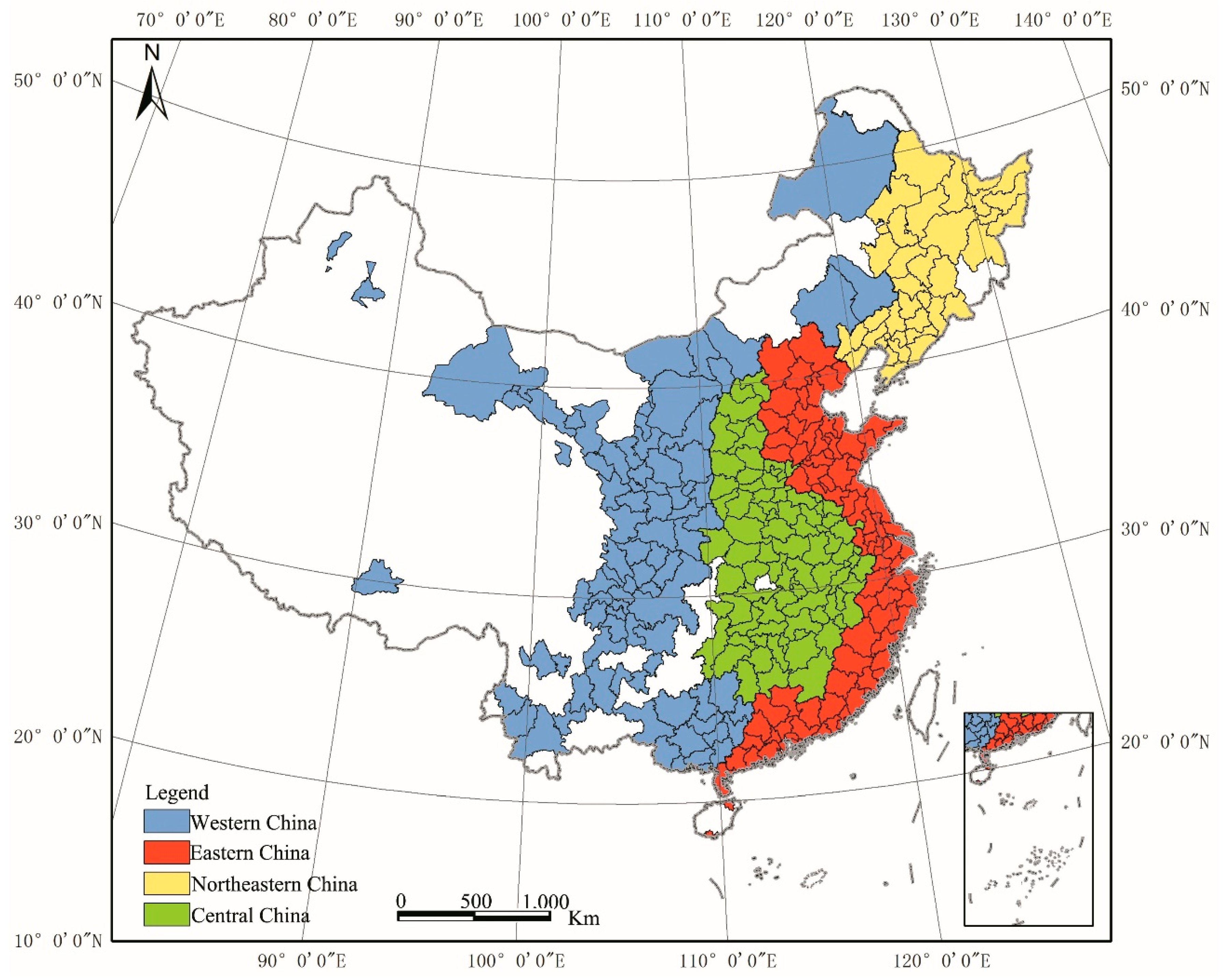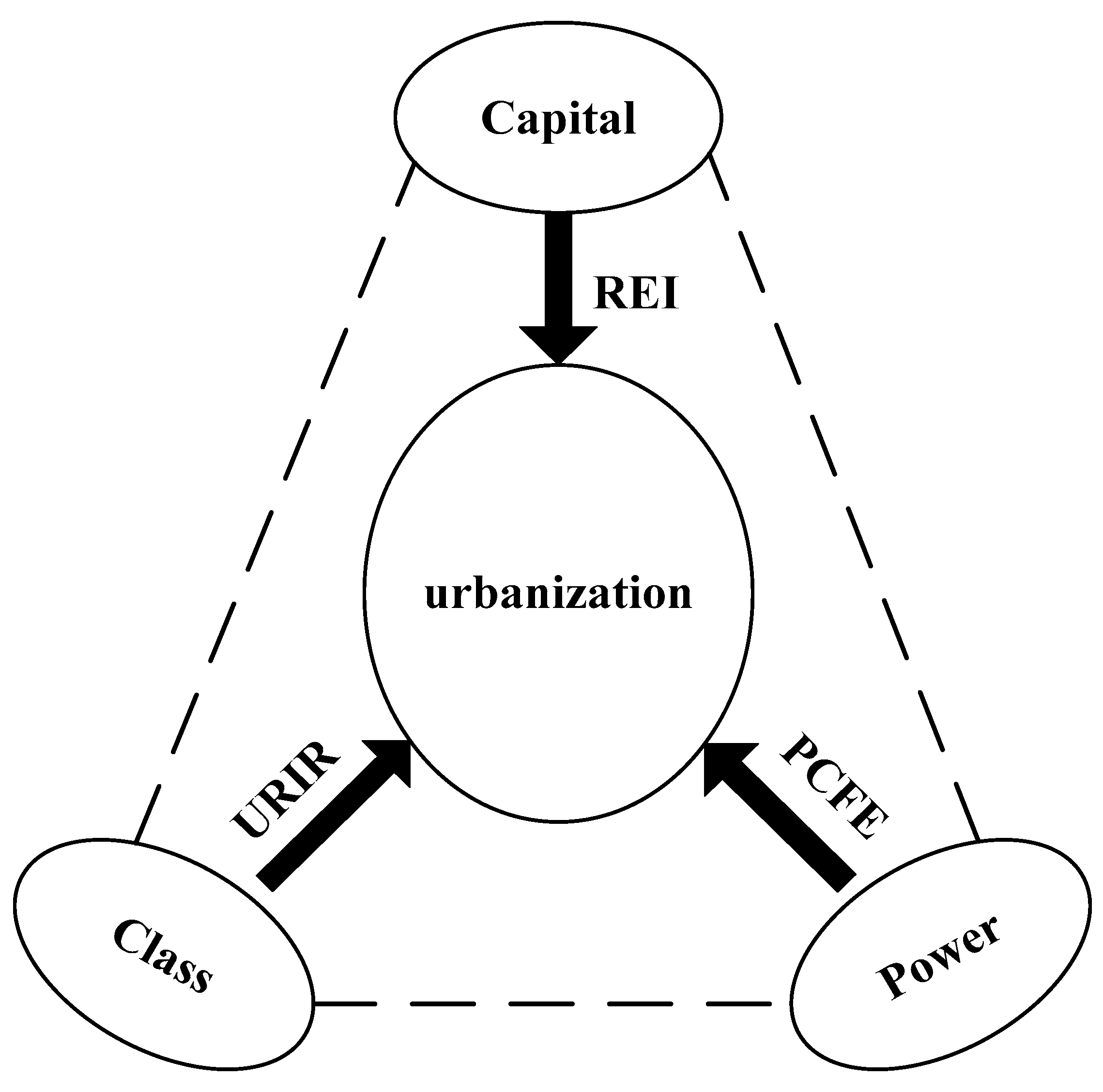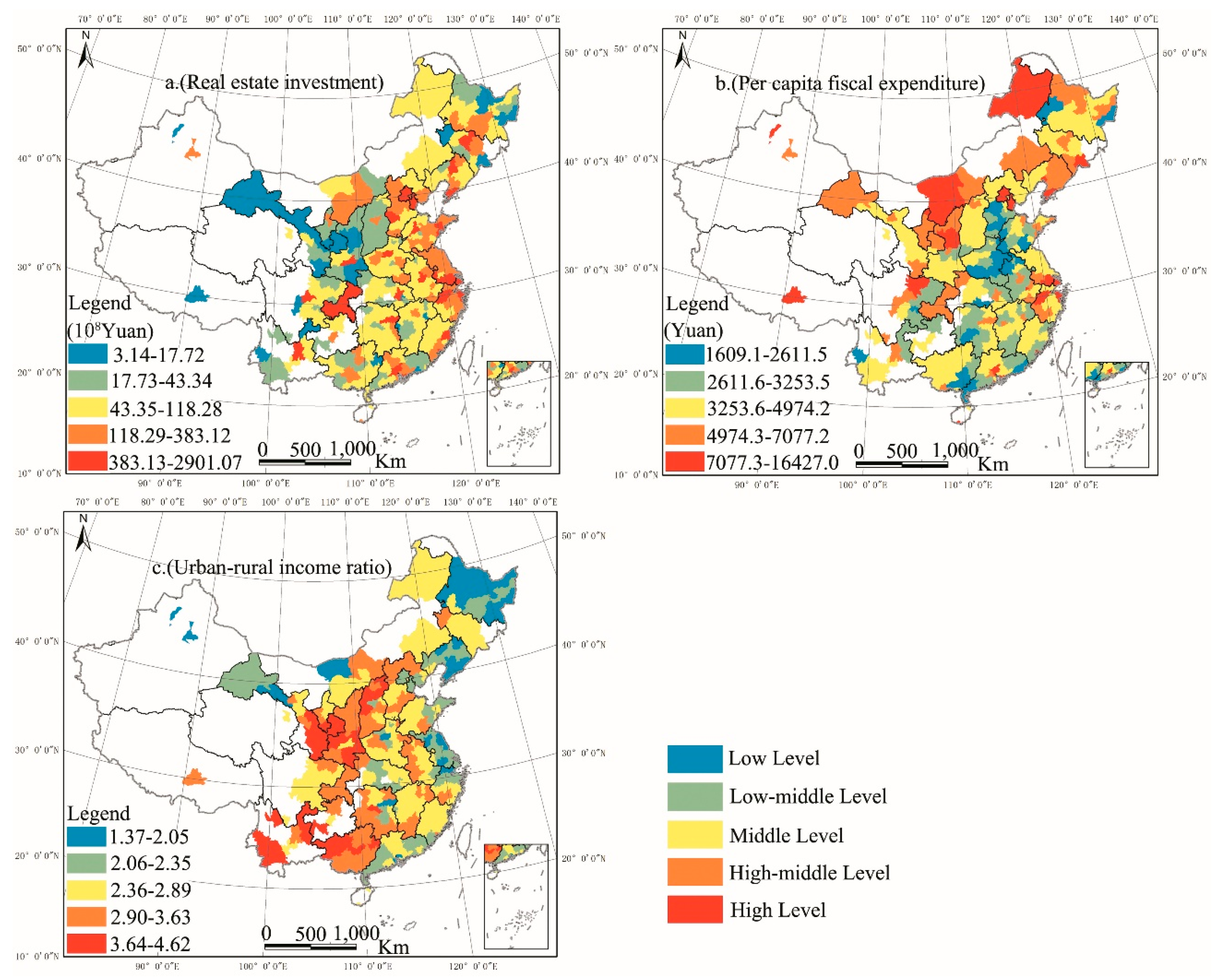Identifying the Determinants of Urbanization in Prefecture-Level Cities in China: A Quantitative Analysis Based on Spatial Production Theory
Abstract
1. Introduction
2. Data and Methodology
2.1. Study Area and Data Issues
2.2. Conceptual Framework and Preliminary Selection of Influencing Factors
2.2.1. Real Estate Investment (Capital) and Urbanization
2.2.2. Per Capita Fiscal Expenditure (Power) and Urbanization
2.2.3. Urban–Rural Income Ratio (Class) and Urbanization
2.3. Methodology
2.3.1. Multiple Linear Regression Model
2.3.2. Geographical Detector Technique
3. Results
3.1. Urbanization in Prefecture-Level Cities
3.2. Factors Influencing the Urbanization Level of China’s Prefecture-Level Cities
4. Discussion
5. Conclusions
Author Contributions
Funding
Conflicts of Interest
References
- Chen, M.; Lu, D.; Zha, L. The comprehensive evaluation of China’s urbanization and effects on resources and environment. J. Geogr. Sci. 2010, 20, 17–30. [Google Scholar] [CrossRef]
- Cohen, B. Urbanization in developing countries: Current trends, future projections, and key challenges for sustainability. Technol. Soc. 2006, 28, 63–80. [Google Scholar] [CrossRef]
- Chen, J. Rapid urbanization in China: A real challenge to soil protection and food security. Catena 2007, 69, 1–15. [Google Scholar] [CrossRef]
- Bloom, D.E.; Canning, D.; Fink, G. Urbanization and the Wealth of Nations. Science 2008, 319. [Google Scholar] [CrossRef] [PubMed]
- Chen, M.; Liu, W.; Tao, X. Evolution and assessment on China’s urbanization 1960–2010: Under-urbanization or over-urbanization? Habitat Int. 2013, 38, 25–33. [Google Scholar] [CrossRef]
- Yang, X.J. China’s Rapid Urbanization. Science 2013, 342. [Google Scholar] [CrossRef] [PubMed]
- Bai, X.; Shi, P.; Liu, Y. Realizing China’s urban dream. Nature 2014, 509. [Google Scholar] [CrossRef]
- Cao, S.; Lv, Y.; Zheng, H.; Wang, X. Challenges facing China’s unbalanced urbanization strategy. Land Use Policy 2014, 39, 412–415. [Google Scholar] [CrossRef]
- Deng, X.; Bai, X. Sustainable Urbanization in Western China. Environment 2014, 56, 12–24. [Google Scholar] [CrossRef]
- Chen, M.; Liu, W.; Lu, D. Challenges and the way forward in China’s new-type urbanization. Land Use Policy 2015, 55, 334–339. [Google Scholar] [CrossRef]
- UNPD (United Nations Population Division). World Urbanization Prospects: The 2018 Revision; United Nations: New York, NY, USA, 2018. [Google Scholar]
- Chen, M.; Zhang, H.; Liu, W.; Zhang, W. The global pattern of urbanization and economic growth: Evidence from the last three decades. PLoS ONE 2014, 9, e103799. [Google Scholar] [CrossRef] [PubMed]
- Seto, K.C.; Sánchez-Rodríguez, R.; Fragkias, M. The New Geography of Contemporary Urbanization and the Environment. Annu. Rev. Environ. Resour. 2010, 35, 167–194. [Google Scholar] [CrossRef]
- Chang, G.H.; Brada, J.C. The paradox of China’s growing under-urbanization. Econ. Syst. 2006, 30, 24–40. [Google Scholar] [CrossRef]
- Zhang, K.H.; Song, S. Rural–urban migration and urbanization in China: Evidence from time-series and cross-section analyses. China Econ. Rev. 2003, 14, 386–400. [Google Scholar] [CrossRef]
- Zhao, S.X.B.; Chan, R.C.K.; Sit, K.T.O. Globalization and the dominance of large cities in contemporary China. Cities 2003, 20, 265–278. [Google Scholar] [CrossRef]
- Güneralp, B.; Seto, K.C. Environmental impacts of urban growth from an integrated dynamic perspective: A case study of Shenzhen, South China. Glob. Environ. Chang. Hum. 2008, 18, 720–735. [Google Scholar] [CrossRef]
- Chen, M.; Huang, Y.; Tang, Z.; Lu, D.; Liu, H.; Ma, L. The provincial pattern of the relationship between urbanization and economic development in China. J. Geogr. Sci. 2014, 24, 33–45. [Google Scholar] [CrossRef]
- He, C.; Chen, T.; Mao, X.; Zhou, Y. Economic transition, urbanization and population redistribution in China. Habitat Int. 2016, 51, 39–47. [Google Scholar] [CrossRef]
- Zhu, J. Transition of villages during urbanization as collective communities: A case study of Kunshan, China. Cities 2018, 72, 320–328. [Google Scholar] [CrossRef]
- Wang, J.; Li, Y. Spatial pattern and influencing factors of urbanization development in China at county level: A quantitative analysis based on 2000 and 2010 census data. Acta Geogr. Sin. 2016, 71, 621–636. (In Chinese) [Google Scholar] [CrossRef]
- Guan, X.; Wei, H.; Lu, S.; Deng, Y. Patterns and driving mechanism of spatialagglomeration during the urbanization process in China. Geogr. Res. 2016, 35, 227–241. (In Chinese) [Google Scholar] [CrossRef]
- Shen, J.; Lin, L. State-sponsored and spontaneous urbanization in Fujian province of China, 1982–2010. Cities 2017, 60, 420–427. [Google Scholar] [CrossRef]
- Shen, J.; Wong, K.-Y.; Feng, Z. State-sponsored and spontaneous urbanization in the Pearl River Delta of South China, 1980–1998. Urban Geogr. 2002, 23, 674–694. [Google Scholar] [CrossRef]
- Shen, J. Understanding dual-track urbanisation in post-reform China: Conceptual framework and empirical analysis. Popul. Space Place 2006, 12, 497–516. [Google Scholar] [CrossRef]
- Shen, J.; Feng, Z.; Wong, K.-Y. Dual-track urbanization in a transitional economy: The case of Pearl River Delta in South China. Habitat Int. 2006, 30, 690–705. [Google Scholar] [CrossRef]
- Sit, V.F.S.; Yang, C. Foreign-investment-induced Exo-urbanisation in the Pearl River Delta, China. Urban Stud. 1997, 34, 647–677. [Google Scholar] [CrossRef]
- Feng, Y.; Kugler, J.; Zak, P.J. Population Growth, Urbanisation and the Role ofm Government in China: A political economic model of demographic change. Urban Stud. 2002, 39, 2329–2343. [Google Scholar] [CrossRef]
- Ma, L.J.C. Urban transformation in China, 1949–2000: A review and research agenda. Environ. Plan. A 2002, 34, 1545–1569. [Google Scholar] [CrossRef]
- Zhang, K.H. What explains China’s rising urbanisation in the reform era? Urban Stud. 2002, 39, 2301–2315. [Google Scholar] [CrossRef]
- Zhou, Y.; Ma, L.J.C. China’s urbanization levels: Reconstructing a baseline from the fifth population census. China Q. 2003, 176–196. [Google Scholar] [CrossRef]
- Zhang, L. Conceptualizing China’s urbanization under reforms. Habitat Int. 2008, 32, 452–470. [Google Scholar] [CrossRef]
- Heikkila, E.J. Three questions regarding urbanization in China. J. Plan. Educ. Res. 2007, 27, 65–81. [Google Scholar] [CrossRef]
- Young, D.; Deng, H. Urbanisation, agriculture and industrialisation in China, 1952–1991. Urban Stud. 1998, 35, 1439–1455. [Google Scholar] [CrossRef]
- Liu, T.; Qi, Y.; Cao, G.; Liu, H. Spatial patterns, driving forces, and urbanization effects of China’s internal migration: County-level analysis based on the 2000 and 2010 censuses. J. Geogr. Sci. 2015, 25, 236–256. [Google Scholar] [CrossRef]
- McGee, T.G. Interrogating the production of urban space in China and Vietnam under market socialism. Asia Pac. Viewp. 2009, 50, 228–246. [Google Scholar] [CrossRef]
- Lefebvre, H. The Production of Space; Blackwell Press: Oxford, UK, 1991; pp. 33–39. [Google Scholar]
- Zhuang, L.; Ye, C. Disorder or reorder? The spatial production of State-Level New Areas in China. Sustainability 2018, 10, 3628. [Google Scholar] [CrossRef]
- Ye, C.; Chen, M.; Chen, R.; Guo, Z. Multi-scalar separations: Land use and production of space in Xianlin, a university town in Nanjing, China. Habitat Int. 2014, 42, 264–272. [Google Scholar] [CrossRef]
- Ye, C.; Chen, M.; Duan, J.; Yang, D. Uneven development, urbanization and production of space in the middle-scale region based on the case of Jiangsu province, China. Habitat Int. 2017, 66, 106–116. [Google Scholar] [CrossRef]
- Brenner, N. The urban question: Reflections on Henri Lefebvre, urban theory and the politics of scale. Int. J. Urban Reg. Res. 2000, 24, 361–378. [Google Scholar] [CrossRef]
- Brenner, N. State territorial restructuring and theproduction of spatial scale:Urban and regional planning in the Federal Republic of Germany, 1960–1990. Polit Geogr. 1997, 16, 273–306. [Google Scholar] [CrossRef]
- Buser, M. The production of space in metropolitan regions: A Lefebvrian analysis of governance and spatial change. Plan. Theory 2012, 11, 279–298. [Google Scholar] [CrossRef]
- Klink, J. Development regimes, scales and state spatial restructuring: Change and continuity in the production of urban space in metropolitan Rio de Janeiro, Brazil. Int. J. Urban Reg. Res. 2013, 37, 1168–1187. [Google Scholar] [CrossRef]
- Leary, M.E. A Lefebvrian analysis of the production of glorious, gruesome public space in Manchester. Prog. Plan. 2013, 85, 1–52. [Google Scholar] [CrossRef]
- Nasongkhla, S.; Sintusingha, S. Social Production of Space in Johor Bahru. Urban Stud. 2013, 50, 1836–1853. [Google Scholar] [CrossRef]
- Li, Z.; Li, X.; Wang, L. Speculative urbanism and the making of university towns in China: A case of Guangzhou University Town. Habitat Int. 2014, 44, 422–431. [Google Scholar] [CrossRef]
- NBSC (National Bureau of Statistics of China). China City Statistical Yearbook 2011; China Statistical Press: Beijing, China, 2011.
- NBSC (National Bureau of Statistics of China). China Statistical Yearbook for Regional Economy 2011; China Statistical Press: Beijing, China, 2011.
- Wang, F.; Zhou, Y. Modelling urban population densities in Beijing 1982–1990: Suburbanisation and its causes. Urban Stud. 1999, 36, 271–287. [Google Scholar] [CrossRef]
- Feng, J.; Zhou, Y.; Wu, F. New trends of suburbanization in Beijing since 1990: From government-led to market-oriented. Reg. Stud. 2008, 42, 83–99. [Google Scholar] [CrossRef]
- Friedmann, J. Four theses in the study of China’s urbanization. Int. J. Urban Reg. Res. 2006, 30, 440–451. [Google Scholar] [CrossRef]
- Chen, M.; Lu, D.; Zhang, H. Comprehensive evaluation and the driving factors of China’s urbanization. Acta Geogr. Sin. 2009, 64, 387–398. (In Chinese) [Google Scholar]
- Sun, Y. The relationship between urbanization and real estate empirical research based on the data of Shandong Province. Int. J. Manag. Stud. Res. 2014, 2, 36–40. [Google Scholar]
- O’Sullivan, A. Urban Economics, 8th ed.; Douglas Reiner: New York, NY, USA, 2012. [Google Scholar]
- Lampard, E.E. The history of cities in the economically advanced areas. Econ. Dev. Cult. Chang. 1955, 3, 81–136. [Google Scholar] [CrossRef]
- Liu, T.-Y.; Su, C.-W.; Chang, H.-L.; Chu, C.-C. Is urbanization improving real estate investment? A cross-regional study of China. Rev. Dev. Econ. 2018, 22, 862–878. [Google Scholar] [CrossRef]
- Linn, J.F. The costs of urbanization in developing countries. Econ. Dev. Cult. Chang. 1982, 30, 625–648. [Google Scholar] [CrossRef]
- Davis, J.C.; Henderson, J.V. Evidence on the political economy of the urbanization process. J. Urban Econ. 2003, 53, 98–125. [Google Scholar] [CrossRef]
- Yu, H. Empirical analysis to urbanization and financial policy in China. Stat. Thinktank 2008, 60–64. (In Chinese) [Google Scholar]
- Liu, H. An empirical analysis of the relevance between urbanization development and fiscal policy. Sub Natl. Fiscal Res. 2013, 52–55. (In Chinese) [Google Scholar]
- Todaro, M.P. A model of labor migration and urban unemployment in less developed countries. Am. Econ. Rev. 1969, 59, 138–148. [Google Scholar] [CrossRef]
- Lewis, W.A. Economic development with unlimited supplies of labour. Manch. Sch. 1954, 139–181. [Google Scholar] [CrossRef]
- Cai, L.; Yao, W. The influence to the new urbanization by the change of incom gap between urban and rural areas: Based on provincial panel data. J. Lingnan Normal Univ. 2017, 38, 78–86. (In Chinese) [Google Scholar]
- Li, J. An empirical study on the relationship between urbanization and urban-rural income gap in Inner Mongolia. Money China 2018, 1–12. (In Chinese) [Google Scholar]
- Wang, Y.; Wang, S.; Li, G.; Zhang, H.; Jin, L.; Su, Y.; Wu, K. Identifying the determinants of housing prices in China using spatial regression and the geographical detector technique. Appl. Geogr. 2017, 79, 26–36. [Google Scholar] [CrossRef]
- Wang, S.; Wang, J.; Wang, Y. Effect of land prices on the spatial differentiation of housing prices: Evidence from cross-county analyses in China. J. Geogr. Sci. 2018, 28, 725–740. [Google Scholar] [CrossRef]
- Cheng, T.; Selden, M. The origins and social consequences of China’s hukou system. China Q. 1994, 139, 644–668. [Google Scholar] [CrossRef]
- Chen, J.; Guo, F.; Wu, Y. One decade of urban housing reform in China: Urban housing price dynamics and the role of migration and urbanization, 1995–2005. Habitat Int. 2011, 35, 1–8. [Google Scholar] [CrossRef]




| Factors | Main Variables | Symbol | Mean | Std.Dev | Min | Max |
|---|---|---|---|---|---|---|
| Capital | Real estate investment (108 Yuan) | REI | 165.08 | 300.77 | 3.14 | 2901.07 |
| Power | Per capita fiscal expenditure (Yuan) | PCFE | 4611 | 2157 | 1609 | 16427 |
| Class | Urban–rural income ratio | URIR | 2.55 | 0.62 | 1.37 | 4.62 |
| Urbanization | Urbanization ratio (%) | UR | 51.56 | 16.17 | 18.71 | 100.00 |
| Variables | Non-Standardized Coefficient | Standard Error | Standardized Coefficient | t-Value | Sig. | Tolerance | VIF |
|---|---|---|---|---|---|---|---|
| Constant | 62.571 | 3.390 | 18.459 | 0.000 | |||
| REI | 0.010 | 0.002 | 0.190 | 4.353 | 0.005 | 0.793 | 1.260 |
| PCFE | 0.003 | 0.000 | 0.441 | 10.135 | 0.000 | 0.797 | 1.255 |
| URIR | −10.887 | 1.046 | −0.414 | −10.405 | 0.000 | 0.950 | 1.053 |
| Statistical Test | |||||||
| R2 | 0.573 | ||||||
| Adjusted R2 | 0.569 | ||||||
| F | 126.804 | ||||||
| REI | PCFE | URIR | |
|---|---|---|---|
| All prefecture-level cities | 0.3199 | 0.3305 | 0.2678 |
| Coastal prefecture-level cities | 0.4048 | 0.4611 | 0.1959 |
| Inland prefecture-level cities | 0.2420 | 0.2603 | 0.2443 |
© 2019 by the authors. Licensee MDPI, Basel, Switzerland. This article is an open access article distributed under the terms and conditions of the Creative Commons Attribution (CC BY) license (http://creativecommons.org/licenses/by/4.0/).
Share and Cite
Yang, Z.; Lei, J.; Li, J.-G. Identifying the Determinants of Urbanization in Prefecture-Level Cities in China: A Quantitative Analysis Based on Spatial Production Theory. Sustainability 2019, 11, 1204. https://doi.org/10.3390/su11041204
Yang Z, Lei J, Li J-G. Identifying the Determinants of Urbanization in Prefecture-Level Cities in China: A Quantitative Analysis Based on Spatial Production Theory. Sustainability. 2019; 11(4):1204. https://doi.org/10.3390/su11041204
Chicago/Turabian StyleYang, Zhen, Jun Lei, and Jian-Gang Li. 2019. "Identifying the Determinants of Urbanization in Prefecture-Level Cities in China: A Quantitative Analysis Based on Spatial Production Theory" Sustainability 11, no. 4: 1204. https://doi.org/10.3390/su11041204
APA StyleYang, Z., Lei, J., & Li, J.-G. (2019). Identifying the Determinants of Urbanization in Prefecture-Level Cities in China: A Quantitative Analysis Based on Spatial Production Theory. Sustainability, 11(4), 1204. https://doi.org/10.3390/su11041204





